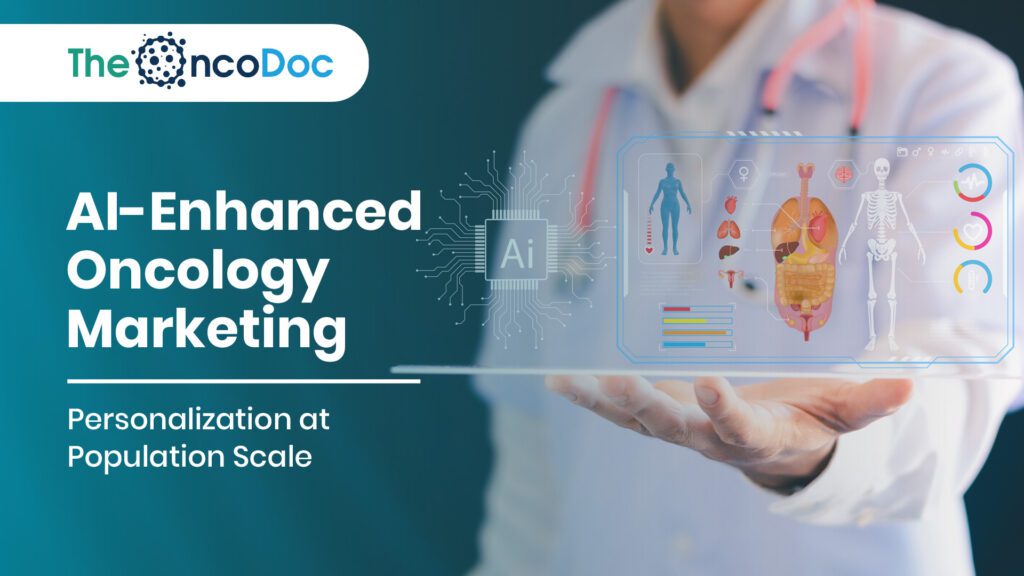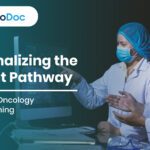Introduction: The New Imperative in Oncology Marketing
As of 2025, oncology stands at a remarkable crossroads brimming with both complexity and promise. Advances in immunotherapy, biomarker-based treatments, and tumor-specific diagnostics are redefining how cancer is approached. Yet, this clinical transformation calls for a parallel shift in how pharmaceutical brands communicate with healthcare professionals (HCPs) and patients alike. The traditional marketing paradigm of broad, uniform messaging has become insufficient.
Artificial Intelligence (AI) now plays a pivotal role in reimagining oncology marketing. Once considered aspirational, AI today facilitates real-time, data-driven decisions, dynamically maps patient journeys, and personalizes content delivery at scale. Rather than targeting broad demographic categories, pharma brands are increasingly adopting a precision-based model reaching individuals with contextually relevant, empathetically tuned messages.
With the rise of precision medicine and increasingly informed patients, expectations for support have evolved. Clinicians, overwhelmed by general content, seek relevance. Patients, empowered by technology and data, demand personalization and clarity. In response, AI is not just an analytical backend tool it’s the engine driving meaningful, compliant, and ethical engagement strategies. The result is a shift from traditional segmentation toward personalization that bridges scientific accuracy with emotional resonance.
This article explores how AI transforms oncology pharma marketing by enabling targeted engagement on a large scale. It delves into technologies like machine learning, natural language processing, and real-world data analytics to illustrate how marketers can offer deeply individualized interactions without losing sight of the human behind the data.
1. AI and the Age of Hyper-Personalization
Hyper-personalization refers to tailoring communication and support based on a person’s specific clinical, behavioral, and emotional profile. In oncology, it may involve directing a specialist to the newest HER2-low therapy data while guiding another HCP toward financial support resources for underserved patients.
AI makes this possible by evaluating hundreds of attributes per user ranging from EHR trends and digital behavior to prescribing patterns and content engagement. Machine learning tools dynamically categorize users into evolving segments, enabling marketers to respond in real-time with precision. Instead of static profiles like “oncologists aged 45+ in metro areas,” AI generates fluid personas that adapt with each new data point.
In oncology, no two journeys are the same; each patient’s diagnosis, treatment path, emotional state, and response to care are deeply personal. Similarly, every healthcare professional (HCP) has distinct clinical interests, patient demographics, and learning preferences. To meet these varying needs, pharmaceutical marketers must move beyond generic outreach. This is where AI steps in.
Hyper-personalization refers to the ability to deliver messages and experiences tailored to each individual based on real-time data and behavioral insights. It goes far beyond traditional segmentation. While older models grouped audiences by broad characteristics like age or region, AI can now synthesize massive datasets to understand and respond to highly specific needs and preferences.
For instance, an oncologist specializing in lung cancer who recently engaged with ASCO content may be presented with the latest research updates or video summaries on targeted therapies. At the same time, a breast cancer survivor in follow-up care may receive educational content about long-term wellness, based on her treatment history and emotional tone detected from app interactions.
AI achieves this through machine learning models trained on diverse data points, electronic health records (EHR), prescribing behaviors, website navigation, social media activity, digital content consumption, and more. These inputs enable dynamic audience profiling, allowing systems to learn and adapt with every click, search, or content interaction.
What makes hyper-personalization powerful is not just its precision but also its scale. AI enables brands to deliver relevant, individualized content to thousands of stakeholders simultaneously, without manual effort. As the system learns, it refines future engagement strategies, making personalization smarter over time.
By integrating emotional intelligence with clinical relevance, AI allows marketers to reach people not just with the right information, but at the right moment and in the right way. This shift transforms communication from transactional to relational; building trust, improving education, and ultimately contributing to better health outcomes.
In this new age, personalization is not a luxury; it is a necessity. And AI is the technology making it possible. The result is communications that feel tailored and relevant, delivered efficiently across large populations.
2. Charting the Shift: Traditional vs. AI-Driven Personalization
Previously, marketing in oncology was guided by limited data points such as ZIP code or average prescription count. Campaigns were designed for the “average” HCP or patient, ignoring the nuance within those categories. This often led to disengagement, as messages lacked individual relevance.
Today’s AI-powered strategies flip that script entirely. The shift is not merely technological but philosophical, moving from static outreach to adaptive, behavior-informed engagement.
Comparison Snapshot:
This visual comparison underscores how AI enables a more intelligent, personalized, and effective form of segmentation.
3. Precision Messaging for Healthcare Professionals
In oncology, every decision is urgent and evidence-driven. HCPs need access to content that is timely, relevant, and aligned with their clinical priorities. Generic campaigns often fall short, resulting in high content fatigue.
AI helps navigate this challenge by analyzing a wide range of signals, from publication history and clinical interests to past engagements and learning preferences. For instance, an oncologist who frequently interacts with PARP inhibitor content can receive curated updates on the topic, via their preferred channel, whether it’s email, mobile app, or webinar. Similarly, community practitioners might prefer concise video explainers and patient case studies over white papers.
Beyond efficiency, this level of personalization fosters trust. When pharma brands deliver content that reflects the HCP’s real-world clinical practice, like biomarker testing protocols or formulary guidelines, they move from being seen as vendors to becoming valued partners in care.
Moreover, AI systems are integrated with compliance frameworks, ensuring that only pre-approved content is served, safeguarding ethical integrity while maximizing engagement.
4. Personalization That Aligns with the Patient Journey
In oncology, communication must resonate not just clinically but emotionally. AI enables marketing to reach patients at key moments, initial diagnosis, treatment changes, remission, or recurrence, offering content that reflects their journey and emotional state.
For example, a patient starting chemotherapy in Delhi may receive culturally appropriate, linguistically customized videos about managing nausea, while a survivor in Pune might access a digital community and follow-up care checklists.
AI can analyze chat sentiment, survey responses, and support requests to detect emotional tone and personalize interactions accordingly. In this way, pharma content becomes not only informative but also comforting, striking the right balance between data and empathy.
5. Orchestrating Omnichannel Experiences with AI
AI isn’t limited to content creation,it choreographs entire engagement journeys. It determines optimal touchpoints: when, where, and how to communicate. For example, a caregiver may engage more effectively through mobile messaging in the evening, while an HCP might prefer scientific literature delivered to their inbox on weekday mornings.
These orchestrated campaigns integrate multiple platforms, social media, portals, emails, rep-triggered actions, driven by centralized AI logic. The system constantly learns, adjusting content based on what has previously led to the best outcomes.
Pharma brands leveraging this orchestration report measurable gains: a 40% boost in content engagement and a 22% improvement in therapy initiation.
6. Ethics and Data Privacy: Essential Pillars of AI Engagement
In oncology, ethical considerations carry immense weight. AI-powered personalization must be rooted in consent, transparency, and respect for privacy. Predictive models can highlight opportunities but must never become manipulative.
For instance, a system may suggest a physician likely to consider a new therapy, but that decision must remain clinician-led. Similarly, patient-facing content must focus on education, not covert marketing.
Sourcing compliant, anonymized data and training AI responsibly is crucial for long-term credibility in the field.
7. Quantifying the Impact of AI
Artificial Intelligence is no longer just a buzzword in pharmaceutical marketing—it is delivering tangible results. In oncology, where both physicians and patients demand precision and empathy, AI is proving its ability to improve engagement and outcomes across multiple touchpoints.
Companies that have adopted AI-powered personalization have seen significant gains. Email campaigns, once ignored, now receive higher open and click-through rates thanks to smarter targeting and personalized timing. Instead of blanket messages, physicians are engaging with content tailored to their specialty, interests, and behavior, leading to deeper interactions.
More importantly, AI is helping patients and HCPs take action. With more meaningful communication, therapy initiation rates have risen. HCPs are spending longer periods interacting with digital content because it aligns with their clinical priorities. Patients, on the other hand, are staying active on digital platforms longer, accessing relevant support tools throughout their treatment journey.
Below is a snapshot of how key performance metrics have improved since AI integration:
These metrics reflect the dramatic improvements seen in campaign performance after implementing AI strategies.
8. Top Channels Where AI Adds Value
Not all digital channels benefit equally from AI integration. Certain platforms are particularly well-suited for AI-driven personalization and performance optimization due to their ability to capture user behavior in real time and deliver tailored experiences.
Social media tops the list as a high-impact channel. It allows for rapid analysis of user interests, engagement patterns, and trending conversations. AI can track how oncologists or patients interact with posts, comments, and shared content, helping marketers deliver targeted updates, patient stories, or medical news that resonate personally.
Personalized email remains a powerful tool when enhanced by AI. Machine learning helps determine the best time to send, the most relevant subject lines, and the ideal content mix based on past engagement. This makes email less of a broadcast tool and more of a curated conversation.
Web portals, including HCP resource centers and patient education hubs, also see strong improvements. AI can tailor the homepage experience, recommend articles or videos based on prior visits, and adapt navigation to user preferences, increasing time spent and repeat visits.
Search engine advertising benefits through real-time bid adjustments and keyword optimization. AI can predict which search behaviors signal treatment intent or professional interest, making campaign performance more efficient.
Lastly, in-app messaging, particularly within patient support apps or HCP tools, allows for personalized nudges and timely alerts. These can range from medication reminders to updates about new clinical guidelines, all delivered in the user’s preferred tone and format.
AI is particularly effective in platforms that enable real-time behavior tracking and rapid content delivery, such as social media and email.
9. Looking Ahead: Adaptive Intelligence and RWD Integration
Tomorrow’s oncology marketing strategies will rely on real-world data more than ever. AI platforms will learn from EMRs, claims data, telehealth sessions, and patient-reported outcomes to recommend content and even clinical pathways in near-real time.
Imagine systems that notify an HCP of a relevant treatment protocol based on patient lab trends—or apps that predict relapse risk based on subtle behavioral cues. That’s the direction AI is leading the industry.
Conclusion: From Campaigns to Collaborative Care
AI has redefined pharma marketing in oncology, not merely as a promotional tool but as a clinical partner. The ability to personalize at scale allows pharma to communicate with empathy, precision, and responsibility.
This shift from broadcast marketing to contextual, ethically guided personalization ensures that the right therapy reaches the right person at the right moment, strengthening trust and improving outcomes.
Those who embrace this transformation with integrity will not only shape the future of oncology marketing ,they will elevate the standard of care itself.
The Oncodoc team is a group of passionate healthcare and marketing professionals dedicated to delivering accurate, engaging, and impactful content. With expertise across medical research, digital strategy, and clinical communication, the team focuses on empowering healthcare professionals and patients alike. Through evidence-based insights and innovative storytelling, Hidoc aims to bridge the gap between medicine and digital engagement, promoting wellness and informed decision-making.



